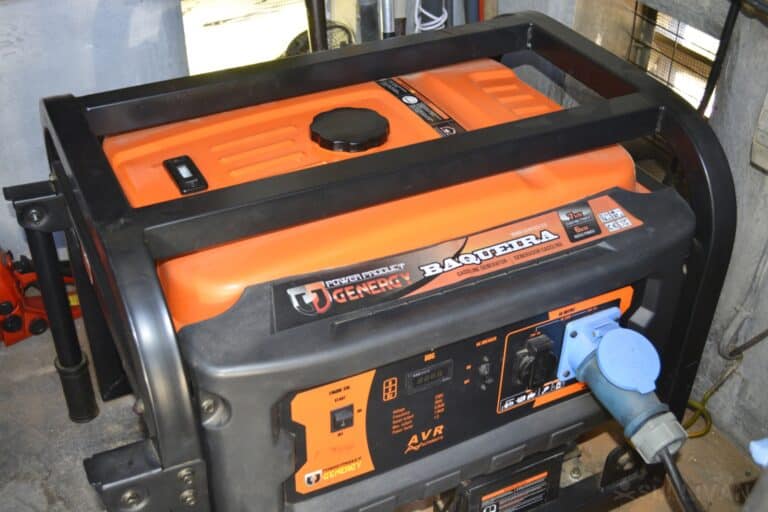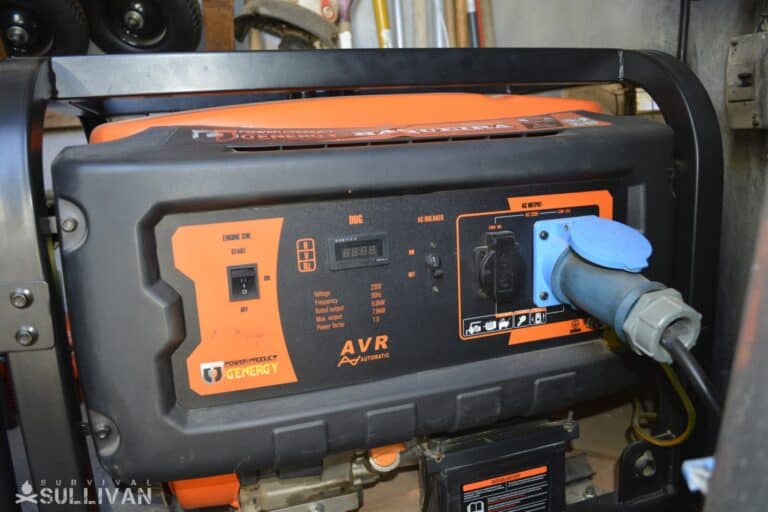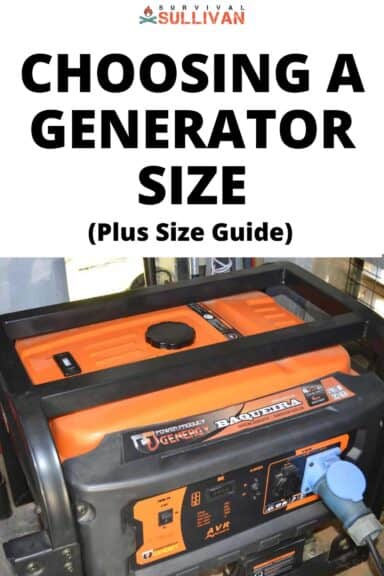I think every prepper knows by now that generators are a wonderful thing to have any time you’re dealing with a power outage, even if it’s just for a short time.

a gas generator
Even in a best-case scenario with a thunderstorm knocking out power for a few hours, your generator might save a fridge and freezer full of food. In a worst-case scenario, you might be depending on it entirely for electricity, and for many weeks or even months on end.
So, knowing how important generators are, why don’t you have one yet? If you’re like most folks, I’d reckon it’s because you don’t know exactly what size a generator you’ll need.
Let’s face it, these things are expensive, and there’s a fine line to walk between saving money and it lacking capability and spending too much for no good reason.
The good news is I’m here to put that worry and anxiety behind you. I’ll tell you everything you need to know to figure out exactly what size unit you need, and for what purposes, in the guide below.
The Fundamental Question: Covering Just the Basics, or Living as You Always Have?
The first thing you need to figure out, before you do anything else, is what your objective is with your generator. I know, I get it: we want to keep the lights on when the power is out, of course! But there’s more to it than that.
You need to figure out exactly how many lights you want to keep on, along with every other electrical appliance in your home, and for how long.
You just want to go with the absolute minimum, a couple of lights, a refrigerator, and maybe a radio? You can get by with a smaller one. If you want to live in comfort complete with AC, heat, and non-essential appliances, you’ll need something far more capable.
And of course, if you want all the bells and whistles and for life to go on more or less as it always has you’ll need even more power.
There’s no one-size-fits-all answer to this question. That’s up for you to decide, or for you to discuss with your family. Once you understand what your requirements are you’ll actually be able to go about figuring out what size generator you need for the job.
| Generator Output, Watts | Can Typically Run… |
| 4,000-6,000 | Fridge/Freezer, Lights, Chargers, Laptop, coffee maker |
| 13,000-15,000 | Fridge/Freezer, Lights, Chargers, Laptop, Oven, Stovetop, Space Heater, small/medium central or window A/C, Water Heater, TV |
| 20,000+ | Fridge/Freezer, Lights, Chargers, Laptop, Oven, Stovetop, Space Heater, any central or multiple window A/C(s), Water Heater, Gas Dryer, Washing Machine, Dishwasher, TVs and Monitors, PC, Garage Door Opener and more |
Can a Generator Power an Entire House?
Yes, it sure can, assuming it is up to the task. A sufficiently powerful generator can power an entire house, inside and out. That means air conditioning, heating, all of your TVs and computers, every light, every appliance, everything – and at all times.
However, for the typical American home housing a family of four this is a very large, powerful, and expensive generator so you need to consider how much your standard of living is worth when it comes to emergency power.
Better Performance = More Money
The bottom line with generators is that you get what you pay for, as a rule, and better performance, meaning more output, scales directly with a higher price tag.
Let’s face it, finances are always a factor, and even the most diligent, dedicated, and selfless prepper knows justifying preparedness equipment you might never need, or need only very seldom, is difficult to do when budgets are lean and times are tight.
This is where the cost-benefit analysis must be done on your generator: you can easily get into a very capable generator that can run one or two major appliances, plenty of lights, and a couple of other odds and ends for under $1,000.
But if you want to keep the whole house and everything in it burning bright, so to say, you might be shelling out $5,000, $6,000, or even more. My advice? Get by with as little as you can stand, plus a little bit extra in case of contingencies.

a gas generator
Two Basic Types of Generators
The next basic decision you’ve got when figuring out how much generator power you’ll need for must-have appliances and fixtures is what type you want.
Standby / Whole-House
Certainly the most convenient option, and one that’s easily capable of keeping your whole house online or nearly so, is a standby generator, sometimes referred to as a whole-house generator for obvious reasons.
These generators are usually fixed in position on a concrete pad near the home and wired directly into the structure’s existing electrical system.
When primary power goes out, they will typically detect the outage, start themselves up, and start supplying electricity again within a few seconds.
Less expensive models might be able to keep your refrigerator and other appliances online but leave you without air conditioning or heat, whereas larger, nicer models will be chosen and installed to give you all the power that your house might require.
Portable
Portable gennys, sometimes called job site generators, are those ones you see on carts, or occasionally mounted directly to trailers in the case of the very largest ones.
These generators vary significantly in capability depending on their size and might be capable of running a few power tools and lights, or powering multiple large and power-hungry appliances. It all just depends.
However, if you’re going to connect directly to your home electrical infrastructure, you must use a transfer switch with them to prevent damage, mishap, and potentially dangerous conditions.
Can You Use a Generator Inside an Apartment?
Generally not, assuming you have a liquid-fueled generator. The reason is that such units always create dangerous gases containing carbon monoxide and other harmful compounds as a consequence of operation.
No matter what, you must never, ever attempt to run a generator inside a building, even if you’re taking pains to ventilate it. You’ll never be able to do it well enough to prevent the buildup of those potentially deadly gases, and every year deaths and injuries occur in the United States because of it.
However, all is not lost. If you have a balcony or a patio, you can place it there to ensure adequate ventilation and then run power via cords inside your unit. Likewise, you might be able to set it up on the walkway of an interior, but open, atrium.
How Do You Know What Size of Generator You Need?
Figuring out exactly what size of generator you need is pretty straightforward once you know how to do the calculations. This is mostly a matter of simple arithmetic.
First, start by consulting the spec sheet for your appliances, lights, and any other electrical appliance or fixture in your home that you want to run when the power is out.
All you need to do is add up the wattage requirement of all of these things and then compare them to the wattage rating of the generator.
For instance, if you want to run several lights, a coffee maker, a refrigerator, a laptop, and a cell phone charger or two, you’ll need anywhere from 2,000 to 3,500 watts total depending on the demands of those things.
If your generator is rated for 4,000 or 5000 watts, for instance, you’re good to go! If it was only rated for 2,000 watts, though, you must think twice because that could be dangerously close to overloading.
Likewise, if you added more appliances like a furnace, air conditioner, oven, washer, and dryer, etc., your total needed watts would be even higher and accordingly, you need a more powerful generator. Pretty simple, yeah?
Understanding Running (Rated) Watts and Starting (Surge) Watts
There’s one more wrinkle you need to understand when calculating the size of generator that you need. The actual power requirements of your appliances and fixtures might actually have two separate phases, so to say.
Put another way, they need different amounts of power when they are starting up, or warming up, and then actually running. We are talking about the running wattage and the starting wattage, sometimes called the surge wattage.
Simply enough, the starting watts are what the device uses when it is actually running and in operation. This number basically does not change…
The startup watts, on the other hand, are what’s required to initiate proper function, and are usually a major concern with larger appliances that have motors or other components with their own significant power demands.
Once these components get running, the overall power use of the device goes back down to the running wattage.
What this means is that you must be prepared for a significantly higher total surge wattage compared to the running wattage. If your genny is rated for 5,000 watts, but all of your appliances and fixtures might produce a peak surge requirement of 6,500 watts, you’re going to have problems.
But this is simple enough to plan for: you must only ensure that your model can handle the highest possible surge wattage of all of the devices and appliances you plan on using, and that of course, it can handle the cumulative running wattage as described above.
Your only other option is to turn on your appliances and devices in a careful order: Those with a higher surge requirement first to avoid an overload, and only then turning on the other things one by one as your unit nears maximum output. Even then, if you cut it close you’ll probably still experience failures or brownouts.
Difference Between Resistive and Reactive Loads
One more thing you need to know about when it comes to generator operation, and it’s related to running watts and surge watts as described in the previous section.
Different types of appliances and fixtures produce different kinds of electrical loads on the unit. These two types are resistive and reactive.
Resistive loads are ones that consume the same amount of power no matter how they’re operated. Good examples are lights, of course, and also your inductive coil appliances like toaster ovens, heaters, conventional ovens, and so forth.
Basically, if the appliance has a resistive element that turns electricity into heat, and or light, you can count on steady power requirements as long as it is drawing electricity from the generator.
And on the other hand, you have reactive loads…
Remember what I said above about devices that use motors or other components like capacitors or batteries that store energy prior to activation? Right, that means that the running power requirements of the appliance might also change.
If the battery needs to be recharged, a motor restarted, a pump activated, etc., then that device might suddenly draw more power than it normally does. Common appliances of this type are refrigerators, washing machines and dishwashers, air conditioners, and all kinds of pumping systems, whether standalone or integral.
Knowing what kind of load an appliance or fixture will subject the generator to is a very important consideration for picking the size and performance of your unit.
It’s also a fine example of why you don’t want to cut too close to the maximum capacity of your model; you’re already riding the red line and, out of nowhere, a reactive load requires more power, and you’ll have a failure.
Other Factors to Consider
We’ve already covered pretty much everything you need to know when it comes to the raw basics of how much generator is required for your purposes, but there is more you should keep in mind before you pull the trigger on a purchase.
Fuel Type
What kind of fuel your unit requires is a major logistical and performance consideration. The most common kinds are gasoline, diesel, and propane, each with its own advantages and disadvantages.
Gasoline is very commonly available, cheap, and offers excellent all-around performance but gas has a very limited shelf life before it goes bad.
Diesel is more expensive, somewhat scarcer at the consumer level, and lasts much longer in storage, but will also go bad in time. Propane is the priciest, but incredibly stable, and has a shelf life in excess of 30 years. Propane generators also tend to be quiet.
Portability
The physical size and weight of the generator is also worth careful consideration. High-output models are invariably much larger and heavier than weaker ones, necessitating the use of a wheeled cart or multiple people to move them during an evacuation…
The largest and most capable ones like whole-house models aren’t intended to be moved at all once they are installed, and if they are nominally mobile, they must be attached to a trailer and towed behind a vehicle.
If you need to reposition your generator or take it with you, you might consider going with a less capable model that’s genuinely portable.
Noise
Noise is a big one, and in ways you might not expect. For starters, in kinder times you’ll have to contend with neighborhood, city, or other jurisdictional laws and codes on noise level.
A more prosaic problem is that an annoying, loud generator is certainly going to pester you, your family, and your neighbors, and they can be very difficult to stifle.
When things have really turned upside down, the noise of a running generator is unmistakable and will attract thieves and people that you don’t want knowing you’ve got it.
To a degree, buying a model or type known for quiet operation might help to mitigate this issue. And speaking of mitigation, there are things you can do yourself to reduce the noise.
Fuel Efficiency
Your generator won’t do a thing for you without any fuel, and so fuel efficiency should be high on your list of concerns when purchasing. Some models are gas hogs, while others comparatively sip at their fuel.
A little variation from one model to the next shouldn’t stop you from considering other, more important factors, but when the difference is several hours of operation for the same amount of output, start paying attention.
Reliability
Generators are like any other machine. They can and will break down, and some are far more prone to break down than others.
Like any other kind of tool, and particularly tools made by the big corporations that we all know, love, or despise, everyone has a favorite. But reliability benchmarks are hotly contested and there’s plenty of unscrupulous advertising and assertions being made out there.
Be willing to put in the due diligence and dig for the laboratory testing, consumer reports, and verified reviews that can give you confidence in the longevity and overall reliability of your trusty genny.
Maintenance Requirements
Of special consideration for preppers are the maintenance requirements of a given generator. Basically, they are motors like any other with some additional components bolted on.
Some are engineered with user-friendliness and ease of maintenance in mind, whereas others are over-engineered, complicated, and will turn a simple oil change into a Sisyphean task.
Consider that you might be responsible for maintaining or even overhauling your generator in a long-term survival situation like a societal collapse. It’s worth investigating how easy it is to maintain before you commit.

The post Choosing the Right Generator Size (Plus Size Guide) appeared first on Survival Sullivan.
https://www.survivalsullivan.com/generator-size/
 CampingSurvivalistHuntingFishingExploringHikingPrivacy PolicyTerms And Conditions
CampingSurvivalistHuntingFishingExploringHikingPrivacy PolicyTerms And Conditions
